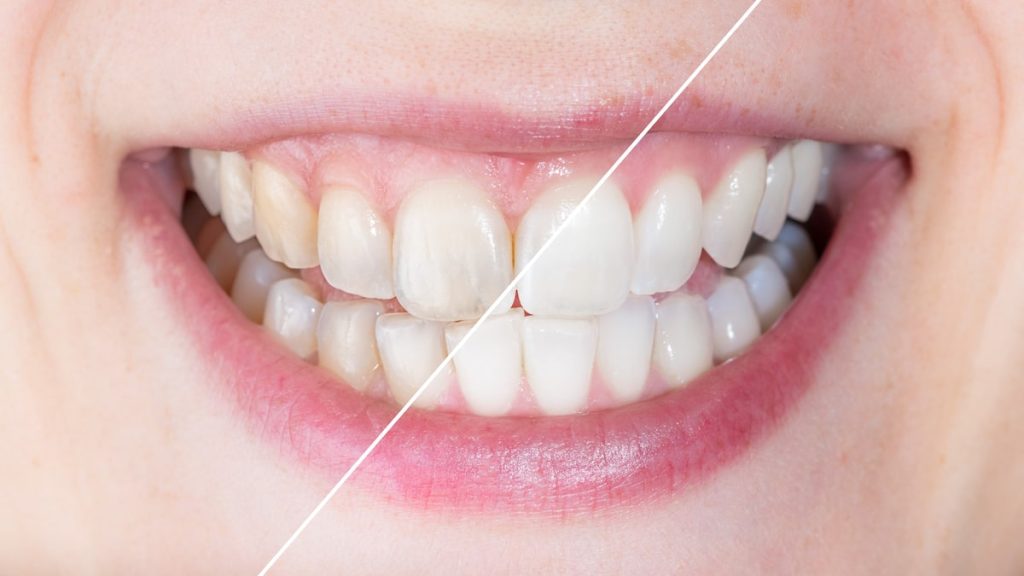Welcome to our comprehensive guide on dental bonding vs veneers!
Are you looking to enhance your smile but not sure which option to choose? Choosing the best cosmetic dentistry procedure for you might be difficult with so many options available. When it comes to repairing chipped, cracked, or discolored teeth, dental bonding, and veneers are two popular options.
Both offer significant benefits, but there are some key differences to consider. In this article, we’ll compare the advantages and disadvantages of porcelain veneers vs bonding so you can decide which procedure is ideal for your smile goals. So, let’s dive in!
Tooth Bonding Technique
Dental bonding is a popular cosmetic dental procedure used to repair and improve the appearance of teeth. It entails coating the surface of the teeth with a tooth-colored resin material, which is subsequently solidified and glued to the tooth with the aid of a special light.
A variety of dental issues, including gaps, discoloration, uneven tooth form or size, chipped or cracked teeth, and chipped or cracked teeth, can be effectively and non-invasively addressed with this technique.
The dental bonding process starts with an initial consultation with a dentist to determine if bonding is the right option for the patient’s specific dental issue. During the bonding procedure, the dentist will clean and prepare the affected tooth by roughening its surface and applying a conditioning liquid to ensure that the bonding material adheres properly. The resin material is then applied in layers to the tooth, and each layer is hardened with a special light. Once the final layer has been applied and cured, the bonded tooth is polished and shaped to match the surrounding teeth for a natural and seamless appearance.
Dental bonding is a quick and painless procedure that typically takes one to two hours per tooth. It is a relatively low-cost cosmetic treatment compared to other dental procedures, such as veneers or crowns. However, bonding may not be as durable as other options and may need to be replaced or touched up after several years. Patients should also be aware that bonded teeth may be more susceptible to staining and discoloration than natural teeth, so proper oral hygiene and regular dental checkups are essential to maintain the appearance and longevity of the bonding material.
Porcelain Veneers Procedure
Dental veneers are thin shells made of porcelain or composite resin that are bonded to the front surface of your teeth. Veneers are an increasingly popular cosmetic dental procedure as they offer a quick and effective way to transform the appearance of your smile. Veneers can be used to correct a variety of dental issues, including teeth that are discolored, chipped, misshapen, or too small.
The veneer procedure typically involves two visits to the dentist. During the first visit, your dentist will prepare your teeth for the veneers by removing a thin layer of enamel from the front of your teeth. This will create space for the veneers and help them bond more securely to your teeth. Next, your dentist will take impressions of your teeth, which will be used to create custom veneers that match the size, shape, and color of your natural teeth.
Dental Veneers
Once the veneers are ready, you will return to the dentist for the second visit. During this visit, your dentist will place the veneers on your teeth and make any necessary adjustments to ensure a comfortable and natural-looking fit. The veneers will then be bonded to your teeth using a special dental adhesive.
With proper care, dental veneers can last for many years. You should continue to brush and floss your teeth as usual, and avoid biting down on hard objects or using your teeth as tools. Regular dental check-ups and cleanings are also important to maintain the health and appearance of your veneers.
It’s important to note that veneers are not a suitable option for everyone. If you have severe dental issues such as decay or gum disease, or if you grind your teeth, your dentist may recommend alternative treatments. Additionally, veneers are an irreversible procedure, as the enamel that is removed from your teeth cannot be replaced. Be sure to discuss your options with your dentist and carefully consider the potential risks and benefits before deciding to proceed with veneers.
Cost of Dental Bonding vs Veneers When Seeing A Cosmetic Dentist
Dental bonding is a relatively inexpensive cosmetic dental treatment that uses a tooth-colored resin material to reshape and restore teeth. The process involves applying the resin to the tooth, molding and shaping it to the desired form, and then curing it with a special light. Dental bonding can be completed in a single office visit and generally costs between $300 and $600 per tooth.
On the other hand, veneers are a more advanced cosmetic dental treatment that involves placing a thin shell of porcelain or composite material over the front surface of teeth. Veneers are custom-made to fit each patient’s teeth, and they can correct a wide range of aesthetic imperfections. Veneers typically require two to three office visits to complete and cost significantly more than dental bonding, with prices ranging from $1,000 to $2,500 per tooth.
The cost difference between dental bonding and veneers reflects the differences in materials, procedures, and customization involved in each treatment. While dental bonding is a quick and affordable option for minor cosmetic issues, veneers are a more comprehensive and durable solution for more significant aesthetic concerns. Ultimately, the choice between dental bonding and veneers depends on the specific needs and budget of each patient, as well as the recommendation of their dentist.
How to Decide Between Dental Bonding vs Veneers
Dental bonding involves applying a tooth-colored composite resin to the surface of the tooth and then shaping and polishing it to blend with the surrounding teeth. This procedure is typically quicker, less invasive, and more affordable than veneers. However, bonding is also less durable and more prone to chipping or staining over time, and it may require touch-ups or replacements every few years. Bonding is a suitable option for minor cosmetic improvements, such as fixing a small chip or discoloration, but it may not be ideal for larger or more complex issues.
On the other hand, veneers are thin porcelain or composite shells that are custom-made to fit over the front surface of the teeth. Veneers can be a longer and more involved process, as it may require removing a small amount of tooth enamel to make room for the veneers. However, they also offer more durability and resistance to staining or wear and tear, and can last for 10 to 15 years or more with proper care. Veneers can provide a more dramatic transformation of the smile and can correct a wider range of dental imperfections, including severe discoloration, misalignment, or uneven teeth.
Ultimately, the decision between dental bonding and veneers depends on a variety of factors, such as the severity and complexity of the dental issue, the patient’s budget and timeline, and their desired outcome. A consultation with a qualified dentist can help determine which option is the best fit for each individual case.
Pros And Cons Of Porcelain Veneers Or Dental Bonding
Porcelain Veneers
Pros of Porcelain Veneers:
- Improved appearance: Porcelain veneers can instantly improve the appearance of your teeth by covering up any dental imperfections, giving you a bright and confident smile.
- Stain-resistant: Porcelain veneers are resistant to stains and discoloration, which means that they will maintain their white and bright appearance for a long time.
- Durable: Porcelain veneers are strong and durable, which means that they can last for 10-15 years with proper care.
- Minimal tooth alteration: Porcelain veneers require minimal tooth alteration, which means that only a small amount of your natural tooth structure needs to be removed for the veneers to be placed.
Cons of Porcelain Veneers:
- Expensive: Porcelain veneers can be expensive, which can be a barrier for some people who are considering this treatment.
- Irreversible: The process of placing porcelain veneers is irreversible, which means that once your natural teeth have been altered, you cannot go back to your original teeth.
- Sensitivity: Some people may experience tooth sensitivity after getting porcelain veneers, especially to hot and cold temperatures.
- Not for everyone: Porcelain veneers may not be suitable for everyone, especially those with weak or damaged teeth, or those with gum disease.
Dental Bonding
Pros of Dental Bonding:
- Affordable: Dental bonding is an affordable cosmetic dental procedure compared to other treatments such as veneers or dental implants.
- Quick and Easy: Dental bonding is a quick and easy procedure that can be completed in a single visit to the dentist’s office.
- Minimally Invasive: Dental bonding is a minimally invasive procedure that does not require any drilling or removal of tooth enamel.
- Versatile: Dental bonding can be used to fix a wide range of cosmetic dental issues, including chips, cracks, discoloration, and gaps between teeth.
Cons of Dental Bonding:
- Less Durable: Dental bonding is not as durable as other dental restorations such as veneers or crowns. Bonded teeth may need to be replaced or repaired after a few years.
- Prone to Staining: Bonding material can be prone to staining and discoloration over time, especially if the patient consumes foods or drinks that can stain teeth.
- Limited Color Matching: It can be challenging to match the color of the bonding material with the natural color of the patient’s teeth, which can result in a less natural-looking appearance.
- Not Suitable for Severe Damage: Dental bonding is not suitable for severe dental damage or decay. In such cases, more extensive dental procedures such as crowns or implants may be necessary.
In the end, deciding between veneers and dental bonding comes down to personal preferences and the specific dental issues you want to address. Both procedures have their pros and cons, so it’s essential to discuss your options with your dentist and consider your budget, timeline, and desired outcome.
Whether you choose dental bonding or veneers, both treatments can transform your smile and boost your confidence. So go ahead, take the first step towards achieving the smile you’ve always wanted, and book a consultation with our specialized dentist today.
Follow Us
Posts
Contact us
Contact Us
Dadeland Town Center One
8950 SW 74 Court, Ste. 1212
Miami, FL 33156



